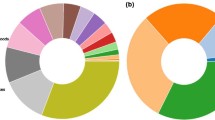Abstract
The Domingos-Richardson model, along with several other infection models, has a wide range of applications in prediction. In most of these, a fundamental problem arises: the edge infection probabilities are not known. To provide a systematic method for the estimation of these probabilities, the authors have published the Generalized Cascade Model as a general infection framework, and a learning-based method for the solution of the inverse infection problem. In this paper, we will present a case-study of the inverse infection problem. Bankruptcy forecasting, more precisely the prediction of company defaults is an important aspect of banking. We will use our model to predict these bankruptcies that can occur within a three months time frame. The network itself is built from the bank’s existing clientele for credit monitoring issues. We have found that using network models for short term prediction, we get much more accurate results than traditional scorecards can provide. We have also improved existing network models by using inverse infection methods for finding the best edge attribute parameters. This improved model was already implemented in August 2013 to OTP Banks credit monitoring process, and since then it has proven its usefulness.
Similar content being viewed by others
Notes
Such attributes are readily available in banking applications.
We will refer to the OTP Bank of Hungary simply as bank from now on.
Uniform 33 % of the cases in each category.
A vertex \(v\) is a supplier if it is at the end of a directed edge.
Here we used a \(N^{++}\) algorithm for community detection, see (Bóta et al. 2010).
The actual outstanding is higher then the given credit-limit.
References
Bóta A, Csizmadia L, Pluhár A (2010) Community detection and its use in Real Graphs. Proceedings of the 2010 Mini-Conference on Applied Theoretical Computer Science - MATCOS 10, 95–99
Bóta A, Krész M, Pluhár A (2013) Approximations of the generalized cascade model. Acta Cybern 21:37–51
Bóta A, Krész M, Pluhár A (2014) The inverse infection problem. In: Proceedings of the 2014 Federated Conference on Computer Science and Information Systems. IEEE, pp 75–83. http://dx.doi.org/10.15439/978-83-60810-58-3
Bóta A, Krész M, Pluhár A (2011) Systematic learning of edge probabilities in the Domingos-Richardson model. Int J Complex Syst Sci 1(2):115–118
Csernenszky A, Kovács Gy, Krész M, Pluhár A, Tóth T (2009) The use of infection models in accounting and crediting. Challenges for analysis of the economy, the businesses, and social progress, Szeged, 617–623
Cao T, Wu X, Hu TX, Wang S (2011) Active learning of model parameters for influence maximization. Lecture notes in computer science, machine learning and knowledge discovery in databases, Springer, Berlin, pp 280–295
Chen W, Yuan Y, Zhang L (2010) Scalable influence maximization in social networks under the linear threshold model. Proceedings of the ICDM ’10 proceedings of the 2010 IEEE International Conference on Data Mining, IEEE Computer Society, pp 88–97
Chen W, Wang C, Wang Y (2010) Scalable influence maximization for prevalent viral marketing in large-scale social networks. Proceedings of the 16th ACM SIGKDD International Conference on Knowledge Discovery and Data Mining, ACM, pp 1029–1038
Diekmann O, Heesterbeek JAP (2000) Mathematical epidemiology of infectious diseases, vol 146. Wiley, Chichester
Domingos P, Richardson M (2001) Mining the network value of costumers. Proceedings of the 7th International Conference on Knowledge Discovery and Data Mining, ACM, pp 57–66
Goyal A, Bonchi F, Lakshmanan LVS (2010) Learning influence probabilities in social networks. Proceedings of the third ACM International Conference on Web search and data mining. ACM, pp 241–250
Granovetter M (1978) Threshold models of collective behavior. Am J Sociol 83(6):1420–1443
Kennedy J, Mendes R (2006) Neighborhood topologies in fully informed and best-of-neighborhood particle swarms. IEEE Trans Syst Man Cybern Part C Appl Rev 36(4):515–519
Kempe D, Kleinberg J, Tardos E (2003) Maximizing the spread of influence though a social network. Proceedings of the 9th ACM SIGKDD International Conference on Knowledge Discovery and Data Mining, ACM, pp 137–146
Kempe D, Kleinberg J, Tardos E (2005) Influential nodes in a diffusion model for social networks. Proceedings of the 32nd International Colloquium on Automata, Languages and Programming (ICALP), Springer, pp 1127–1138
Kimura M, Saito K (2006) Tractable models for information diffusion in social networks. Lecture notes in computer science, Knowledge Discovery in Databases, Springer, Berlin, pp 259–271
Krész M, Pluhár A (2014) Prediction of economic and social events by infection processes. Encyclopedia of social network analysis and mining, Springer
Acknowledgments
The first and last authors were partially supported by the European Union and the European Social Fund through project FuturICT.hu (Grant no.: TÁMOP-4.2.2.C-11/1/KONV-2012-0013). The fifth author was partially supported by the European Union and co-funded by the European Social Fund through project HPC (Grant no.: TÁMOP-4.2.2.C-11/1/KONV-2012-0010).
Author information
Authors and Affiliations
Corresponding author
Rights and permissions
About this article
Cite this article
Bóta, A., Csernenszky, A., Győrffy, L. et al. Applications of the inverse infection problem on bank transaction networks. Cent Eur J Oper Res 23, 345–356 (2015). https://doi.org/10.1007/s10100-014-0375-2
Published:
Issue Date:
DOI: https://doi.org/10.1007/s10100-014-0375-2




